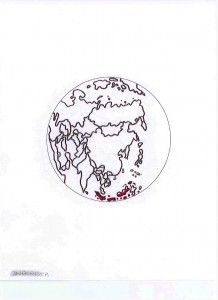INDONESIA
A. THE COUNTRY
The Republic of Indonesia, is a country in Southeast Asia and Oceana
consisting of thirty-three provinces and comprising 17,508 islands.
There are numerous volcanoes and frequent earthquakes.
Some of the more significant islands and island archipelago include:
Sumatra, Java, Bali, West Lesser Sundra Islands, East Lesser Sundra
Islands, Kalimantan, Sulawesi, Maluku, [West] Papua.
The government, an unitary presidential republic, is the world’s third-largest
democracy. The diverse economy is based on natural gas, forest
products, agriculture and textiles, with large reserves of many
minerals. The service industry is the largest employer. Indonesia’s
vast areas of wilderness support the world’s second highest level of
biodiversity, but there are serious environmental issues as a result of
high population and rapid industrialization. There is political and
religious instability and endemic corruption. The fledgling democratic
government faces a huge task to see political, economic and social
renewal.
B. THE PEOPLE
The population is ~232,517,000 and the official language is Indonesian.
The population is diverse with over 750 distinct peoples. Close to
one-sixth of the population lives below the poverty line. Displacement
of people within, and out of, Indonesia is massive and has many causes.
Politico-religious agendas mean that many non-Muslim minorities will be
undercounted: ~94.3% are Indo-Malay, ~3.9% Chinese, ~0.6% Pacific
Island peoples, ~1.2% Other.
C. RELIGIONS AND CHRISTIANITY/PENTECOSTALISM
Only six religions are officially recognized: Islam, Hinduism, Buddhism,
Confucianism, Catholicism and Protestantism. Islam’s strength and
influence in numbers and power allow it to pressure the religious scene,
giving itself preferential treatment and limiting Christian activities
and public presence.
Religious figures, official and unofficial, often differ widely.
~80.31% are Muslim, ~15.85% claim to be Christian, ~1.3% Hindu, ~1.2%
Ethnoreligionist, ~0.9% Chinese, ~0.4% Buddhist, ~0.04% Non-religious.
In the Christian category:
~10.17% are Protestant, ~3.04% Catholic, ~1.87% Unaffiliated, ~0.65%
Independent, <0.01% Orthodox, <0.01% Anglican, and ~0.12% are considered
marginal in this category.
Evangelicals represent ~5.6% of the population.
Charismatics represent ~4.4% and of those ~3.9% are Pentecostals.
Donna Siemens
References:
http://en.wikipedia.org
Operation World, Jason Mandryk. Colorado Springs: Biblica Publishing, 2010.

